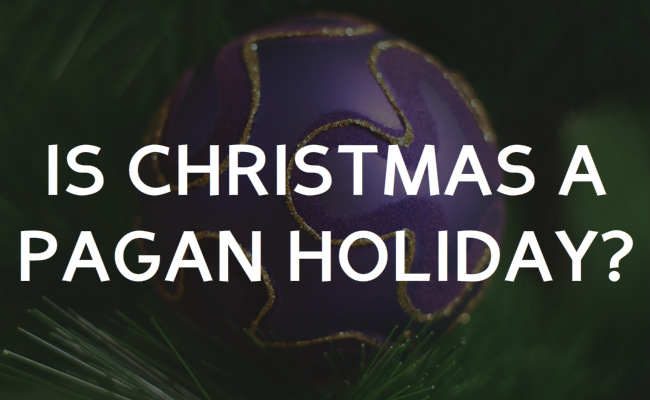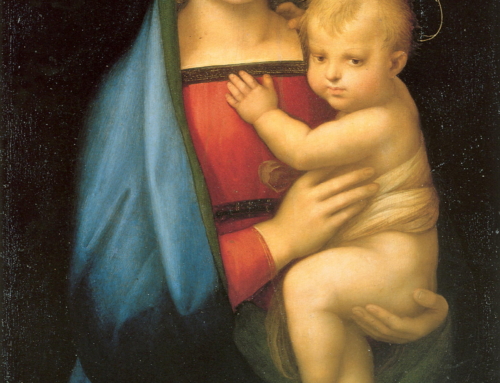At this time of year you will hear the same tired old theory that Jesus was born in the Spring and Christmas in December is just a carry over from paganism.
Stop. This is not true.
This post is a shortened version of a longer post in the archived articles section. You can read the whole thing here.
Before we take this dumb theory apart we should understand where it came from. It is true that the Romans had a mid winter celebration called Saturnalia. From December 17-23 they partied with feasting and foolishness. It was a week of food, frivolity, high table and hi-jinks.
Then, so the cynical story goes, when the Emperor and his mother converted to the Christian faith, the new spoil sport religion frowned on such decadence, but the people still wanted to party. So the pope came up with a great idea. “I know! Let’s have Christmas instead!”
Could the theory be true? When trying to solve the mystery of the relationship between Christmas and the Saturnalia we have to consider not only the similarities, but the differences. The Saturnalia was celebrated from December 17 – 23. Okay that’s pretty close to the December 25 date for Christmas–but if they were copying the Saturnalia, why didn’t the early Christians celebrate the Nativity of Christ on December 17? At the Saturnalia they had a feast. Good. Christians had a feast too. The Romans gave each other gifts as part of the celebration. There’s a match. Christians did too. However, the Romans also wore silly hats, got drunk, danced naked in the streets, propped up the statue of Saturn on a couch to observe the revelries, reversed roles between slaves and masters, and put green drapes around their doorways. None of those fun activities are part of Christmas.
The most glaring difference is in the meaning of the celebration itself. If there were some sort of link with the birth of Christ you would expect that the meaning of the Saturnalia might have something to do with the coming of light in the dark time of the year or the birth of new life in the midst of the cold and dark. The Saturnalia has none of those themes. Instead, Saturn was the god of agricultural plenty, with the shadow side, (in the earlier myths) of being associated with human sacrifice. It’s roots are in the old, “Let’s sacrifice some of our kids to appease the god so he’ll make our crops grow” type of paganism. Nothing there about the light dawning in the darkness or the blessing of new life in the midst of the bleak mid winter. So in fact, about the only things that are similar between Christmas and the Saturnalia are that they both happened in December, people had a nice meal and gave gifts to each other.
Not so fast. The plot thickens
The Saturnalia may not have had any meaningful link with Christmas, but there was a pagan festival for the solstice which did celebrate the coming of the light and victory over darkness, and it was celebrated on December 25. Instead of a link between Christmas and the Saturnalia scholars suggest that the date of Christmas was a Christian takeover of the feast of Dies Natalis Sol Invictus–the birthday of the Roman sun god Sol.
The problem is– this Roman feast is a late innovation. In the year 278AD (well after Christianity began to burgeon across the empire) the Emporer Aurelian began to promote the cult of Sol Invictus. There is no evidence that the birth of Sol Invictus was celebrated on December 25 until around 360 AD. This is well after the date of Emperor Constantine’s conversion in 315, and during the influence of Julian the Apostate–who attempted to turn back the tide of Christianity and return Rome to its pagan origins.
Therefore instead of Christians adopting a pagan holiday and making it their own it’s probably exactly the reverse: the pagans–being threatened by Christianity–copied the Christian celebration. The celebration of the Nativity of Sol Invictus was a late pagan attempt to compete with the celebration of the Nativity of Christ the Lord–the Dayspring from on High and the Sun of Righteousness– on December 25.
So where did the date of Christmas originate?
In 386 St John Chrysostom preached a sermon linking the date for Christmas to the date of the Annunciation. He does so in a way that suggests that this was already an established belief. The date of the Annunciation was based on a Jewish tradition that the world was created on March 25. The Jews also believed that a great man would die on the same day as his conception. The date for Jesus Christ’s death was Nisan 15 according to the Jewish calendar, or March 25 according to the Roman calendar. The early Christians (who were of course Jews) concluded that Jesus was therefore conceived on March 25. Thus the day of the world’s creation, and the day of the world’s redemption (and therefore the beginning of the new creation) was March 25.
It’s easy. If the Lord Jesus Christ was conceived on March 25, then he was born nine months later on December 25. The date for Christmas is therefore determined by the date of the Annunciation and has nothing to do with the Roman celebration of the Saturnalia or the celebration of the birthday of Sol Invictus.
Was Jesus born in the Spring? This idea came about because people noticed that sheep drop their lambs in the Spring, and if the shepherd were in the fields all night long, they would only be there through the night to assist the sheep who were giving birth. So it makes sense that Jesus was born in the Spring, not in December.
BUT. Again, the easy answer to the mystery is not always the right answer. Lambing in Spring is a European phenomenon.
This article discusses the breed of sheep that is common in the Middle East and their gestation period is different.
The Awassi sheep is a desert sheep, a fat-tailed breed that has existed in the Middle East for an estimated 5,000 years. It is the only indigenous breed of sheep in Israel. They are raised for wool, meat, and milk. Awassi sheep breed in the summer and drop lambs in the winter, when there is sufficient pasture for the ewes in milk. In Israel, the principal lambing season is December through January.
These are the kind of historical details I uncovered in my book Mystery of the Magi-the Quest to Identify the Three Wise Men. When you stop accepting the seemingly easy answers and dig a big deeper, you find the truth is amazing, and with modern archeological and forensic techniques more and more of these truths are being discovered.







[…] American Catholic Is This the Same Manger That Jesus Was Placed In? – Billy Ryan, uCatholic Is Christmas in December a Pagan Carryover? – Fr. Dwight Longenecker Christmas in Beijing: An Apple for Peace, the Crib “in the […]
[…] pagã do nascimento do Deus Sol. Essas teorias já foram completamente desmascaradas. Ir aqui para ver este mito […]
[…] pagan celebration of the birth of the Sun God. These theories have now been debunked thoroughly. Go here to see this myth […]